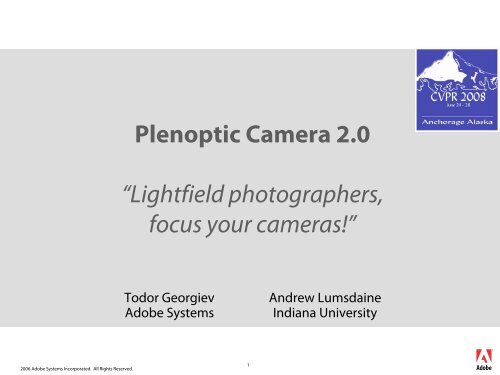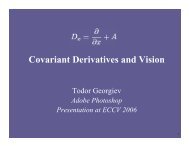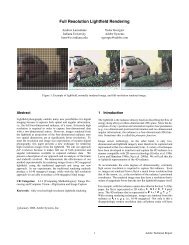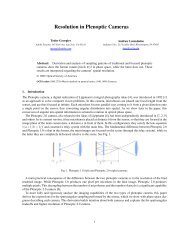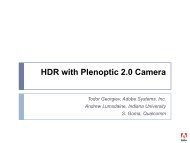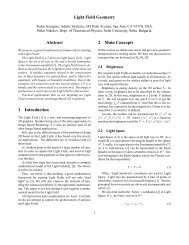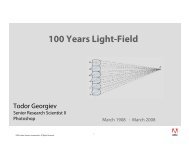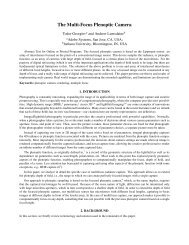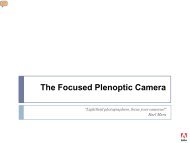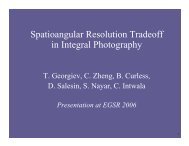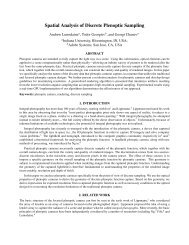Supplemental - Todor Georgiev
Supplemental - Todor Georgiev
Supplemental - Todor Georgiev
Create successful ePaper yourself
Turn your PDF publications into a flip-book with our unique Google optimized e-Paper software.
Plenoptic Camera 2.0<br />
“Lightfield photographers,<br />
focus your cameras!”<br />
<strong>Todor</strong> <strong>Georgiev</strong><br />
Adobe Systems<br />
Andrew Lumsdaine<br />
Indiana University<br />
2006 Adobe Systems Incorporated. All Rights Reserved.<br />
1
Summary<br />
Plenoptic cameras produce final rendered image with very low resolution, one pixel per microlens.<br />
Is it possible to improve this resolution and finally make lightfield photography practical?<br />
The main idea behind this work is that the reason for the low resolution is that Plenoptic cameras<br />
are not properly focused on the object we are imaging. With appropriately focused plenoptic<br />
camera and a new rendering algorithm we can produce a final image utilizing multiple pixels per<br />
microlens, thus significantly increasing resolution.<br />
Plenoptic cameras have 2 lens systems: the main lens and the microlens array. While the main lens is<br />
focused as in a conventional camera, the microlenses are focused at infinity rather than on the object<br />
we are imaging. The consequent assumption is that each microlens image is completely defocused<br />
and only a single pixel in the final image can be rendered from it.<br />
In this work we show that if we instead focus the microlenses on the image plane of the main lens,<br />
we can achieve an extraordinary increase in resolution of the final rendered image. This can be<br />
done with two different approaches, one using the Galilean telescope, the other one using the<br />
Keplerian telescope imaging model. The plenoptic camera itself becomes an array of telescopes with<br />
a common objective lens.<br />
2006 Adobe Systems Incorporated. All Rights Reserved.<br />
3
Two types of telescopes<br />
• Galileo’s first telescope, 1609<br />
• Kepler’s new design, 1611<br />
2006 Adobe Systems Incorporated. All Rights Reserved.<br />
3
Integral Photography 1908<br />
2006 Adobe Systems Incorporated. All Rights Reserved.<br />
4
Adelson 1992, Plenoptic Camera<br />
Designed with the idea to solve Computer Vision problems<br />
Previous versions from H. Ives and others<br />
2006 Adobe Systems Incorporated. All Rights Reserved.<br />
5
Ren Ng: Photography with plenoptic camera (Tech Report 2005)<br />
2006 Adobe Systems Incorporated. All Rights Reserved.<br />
6
Ren Ng: Photography with plenoptic camera (Tech Report 2005)<br />
2006 Adobe Systems Incorporated. All Rights Reserved.<br />
7
Ren Ng: Photography with plenoptic camera (Tech Report 2005)<br />
2006 Adobe Systems Incorporated. All Rights Reserved.<br />
8
Our classification of<br />
lightfield data<br />
2006 Adobe Systems Incorporated. All Rights Reserved.<br />
9
Behavior of Ren’s images<br />
2006 Adobe Systems Incorporated. All Rights Reserved.<br />
10
Three types of behavior of radiance images:<br />
2006 Adobe Systems Incorporated. All Rights Reserved.<br />
11
Ng’s photography with plenoptic camera: Resolution is low!<br />
2006 Adobe Systems Incorporated. All Rights Reserved.<br />
12
Integral View Photography (<strong>Georgiev</strong>&Intwala, 2006)<br />
Ren’s design: Main lens focused on the micro lenses<br />
T L<br />
= Translation o Lens<br />
2006 Adobe Systems Incorporated. All Rights Reserved.<br />
13
Integral View Photography (<strong>Georgiev</strong>&Intwala, 2006)<br />
Ren’s design: Main lens focused on the micro lenses<br />
Is that the only way to do it?<br />
T L T<br />
= Translation o Lens o Translation<br />
Our suggestion: Shift image by one focal length (See next)<br />
2006 Adobe Systems Incorporated. All Rights Reserved.<br />
14
Integral View Photography (<strong>Georgiev</strong>&Intwala, 2006)<br />
Main lens -- focused in front of the microlenses, not on the microlenses:<br />
The plenoptic camera is besed on multiple use of an optical device that consists<br />
of a microlens of focal length f and a distance f behind it. This device is described<br />
by the transfer matrix M. We redefine it as translation-microlens-translation.<br />
2006 Adobe Systems Incorporated. All Rights Reserved.<br />
15
Lumsdaine&<strong>Georgiev</strong>, 2008<br />
This formula shows the image plane does not have to be on the<br />
microlenses. It can be shifted any distance X from the microlenses,<br />
and they will still capture the angular component of the radiance<br />
because the top left matrix element is 0.<br />
T L X<br />
2006 Adobe Systems Incorporated. All Rights Reserved.<br />
16
Lumsdaine&<strong>Georgiev</strong>, 2008<br />
What is the condition for exact focusing with a shifted image?<br />
Answer: Simple relay imaging!<br />
This is like a telescope with multiple eyepieces.<br />
2006 Adobe Systems Incorporated. All Rights Reserved.<br />
17
Lumsdaine&<strong>Georgiev</strong>, 2008<br />
Plenoptic Camera<br />
Focused Plenoptic Camera<br />
2006 Adobe Systems Incorporated. All Rights Reserved.<br />
18
Lumsdaine&<strong>Georgiev</strong>, 2008<br />
Two ways of focusing:<br />
Galilean and Keplerian<br />
2006 Adobe Systems Incorporated. All Rights Reserved.<br />
19
Lumsdaine&<strong>Georgiev</strong>, 2008<br />
Galilean telescopic array<br />
Keplerian telescopic array<br />
2006 Adobe Systems Incorporated. All Rights Reserved.<br />
20
Lumsdaine&<strong>Georgiev</strong>, 2008<br />
2006 Adobe Systems Incorporated. All Rights Reserved.<br />
21
Lumsdaine&<strong>Georgiev</strong>, 2008<br />
Galilean imaging<br />
Keplerian imaging<br />
2006 Adobe Systems Incorporated. All Rights Reserved.<br />
22
Lumsdaine&<strong>Georgiev</strong>, January 2008<br />
For comparison with traditional lightfield rendering see videos:<br />
http://www.tgeorgiev.net/FullResolution.wmv<br />
http://www.tgeorgiev.net/FullResolution.gif<br />
For demonstration of refocusing with full resolution rendering, see:<br />
http://www.tgeorgiev.net/FullResolutionRefocusing.gif<br />
2006 Adobe Systems Incorporated. All Rights Reserved.<br />
23
Sampling pattern in Plenoptic Camera 2.0<br />
“It's my intuition that it takes advantage of scene statistics in the natural world”<br />
“I believe that these are the same properties of the world that make the coded<br />
aperture camera possible”<br />
-- Ted Adelson<br />
2006 Adobe Systems Incorporated. All Rights Reserved.<br />
24
Sampling pattern in Plenoptic Camera 2.0<br />
Plenoptic Plenoptic 2.0<br />
Please, see the formulas that motivate this (next)<br />
2006 Adobe Systems Incorporated. All Rights Reserved.<br />
25
Sampling pattern in Plenoptic Camera 2.0<br />
Camera matrix (as in the tutorial)<br />
Condition for focusing<br />
Sensor surface is mapped to the<br />
image plane by this matrix<br />
2006 Adobe Systems Incorporated. All Rights Reserved.<br />
26
Sampling pattern in Plenoptic Camera 2.0<br />
Example: a=1, b=1, f= ½<br />
The image is mapped to the object by:<br />
When a is big and b is small, the parallelogram gets stretched, and slope gets small<br />
2006 Adobe Systems Incorporated. All Rights Reserved.<br />
27
Sampling pattern in Plenoptic Camera 2.0<br />
Plenoptic 2.0 sampling is more flexible:<br />
By spacing the microlenses we can choose the spatial-angular tradeoff point.<br />
We can actually reach very low angular resolution not possible with<br />
traditional plenoptic camera (because edge effects would introduce noise).<br />
Very high spatial resolution can be achieved!<br />
2006 Adobe Systems Incorporated. All Rights Reserved.<br />
28


